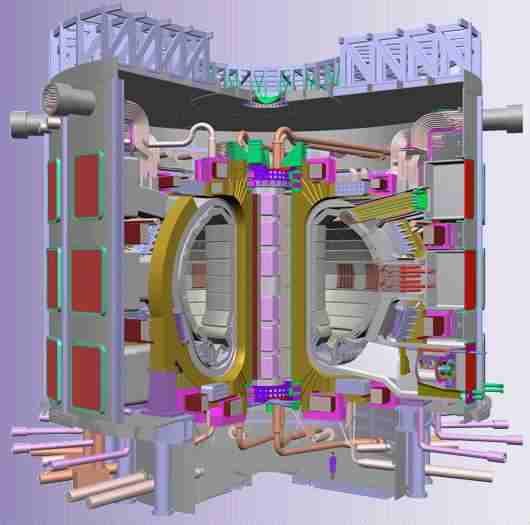
Fusion Evaluated Nuclear Data Library - FENDL-3.2b
(Nuclear data supersede all previous versions of FENDL-2.x and 3.x libraries)
Coordinators: Georg
Schnabel, and Roberto
Capote, and Andrej Trkov
LAST WEBPAGE UPDATE: Feb 15,
2022
FENDL-3.0 PRIMARY
REFERENCE:
R. Forrest, R. Capote, N. Otsuka, T. Kawano, A.J. Koning,
S. Kunieda, J-Ch. Sublet, and Y. Watanabe, INDC(NDS)-0628
(IAEA, Vienna, 2012).
(note: A new comprehensive documentation of the FENDL library is in preparation).
The Fusion Evaluated Nuclear Data Library contains reaction data with a focus on the data requirements of fusion research facilities. Both operating and future facilities (e.g., ITER,DEMO, IFMIF) data needs are covered with current data extended up to 150 MeV. Development of FENDL libraries is described in the document links provided in the left column; links to previous FENDL releases are also listed. The ENDF files and thereof derived processed files available on this website correspond to this commit on GitHub.
Library Contents: Transport
The FENDL-3.2b transport package contains evaluated nuclear data in ENDF-6 format as General Purpose files. Data are given for neutron-, proton- and deuteron-induced reactions. All ENDF files of the neutron sublibrary cover at least incident energies up to 60 MeV and typically extend up to 150 MeV. All ENDF files in the proton sublibrary go up to at least 100 MeV and often to 3 GeV. All ENDF files in the deuteron sublibrary cover the energy range to exactly 200 MeV. Details about the energy range of individual ENDF files can be seen in the sublibrary summary tables linked below. Data processing for transport applications has been undertaken (neutron data processing is similar to the processing of the FENDL-3.0 library described in INDC(NDS)-0611 report). Importantly, the official NJOY2016 source code was adjusted to ensure the proper processing of the nuclear data libraries provided by the IAEA. For FENDL, this NJOY2016 version has been used. More details of the FENDL-3.2b data processing will be provided in the final FENDL paper, which is in preparation. The following processed files for applications are given:
- FENDL/MC: Pointwise continuous-energy cross section data in ACE format for MCNP calculations; also includes probability tables (PT) in the unresolved resonance range.
- FENDL/MG: Contains multigroup cross section data in the
211n/42g Vitamin J+ energy structures (the 211n Vitamin J+
energy structure matches with the 175n Vitamin J energy
structure below 19.64 MeV) for multigroup transport codes in
two formats:
- FENDL/MG (MATXS), which includes files in MATXS format from the NJOY module MATXSR.
- FENDL/MG (GENDF), which contains data in GENDF format from the NJOY modules GROUPR and GAMINR.
- Data are available for 192 materials relevant for fusion at 293.6K. Additionally, the SIGACE package can be downloaded for Doppler broadening of ACE-formatted file - useful for generating ACE-formatted files at temperatures higher than 293.6K.
Notes on uncertainties: If covariance data are not available for a particular element of interest, covariance data of other libraries may be used (e.g., from TENDL-2019 library).
Changes since FENDL-3.2:
- The neutron ENDF files of Fe-54, Fe-56, Fe-57 were taken from the INDEN project
- The neutron ENDF file of O-16 was updated at the Nuclear Data Section of the IAEA to improve heating compared to FENDL-3.2 while preserving the neutron flux at high energies.
- Minor change in the MF6/MT700 energy-angular distribution representation of B-10 to improve the recoil heating calculation.
Recommendations
Activation
The TENDL-2017 library is recommended for activation calculations.
Note that selected activation channels
for neutron induced reactions which are included in the IRDFF-II library
may contain better quality evaluations than those listed in TENDL-2017 However, IRDFF-II should not be used as a
comprehensive activation library as many activation reactions are not included in IRDFF-II not being neutron dosimetry reactions.
A similar situation arises for many proton and deuteron induced reactions evaluated for medical radionuclide production (e.g.,
see evaluated data for charged-particle induced monitor reactions,
for production of gamma-emitters for medical applications,
for production of positron-emitters for medical applications,
and for production of therapeutic radionuclides).
Dosimetry
The IRDFF-II library (International Reactor Dosimetry and Fusion File) released by the IAEA in January 2020 is recommended for neutron dosimetry in fusion facilities.
Download
The zipped files contain the entire library of a certain type.
| Library | Sublibrary | ENDF | PENDF | ACE | MATXS | GENDF | GND |
|---|---|---|---|---|---|---|---|
| FENDL-3.2b (transport) | Neutron | [zip] | [zip] | [zip] | [zip] | ||
| Photo-atomic | [zip] | [zip] | |||||
| Proton | [zip] | [zip] | |||||
| Deuteron | [zip] | [zip] |